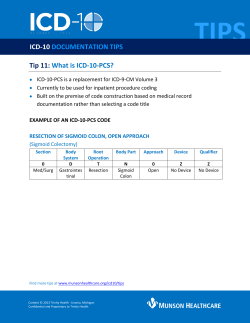
Giant Sigmoid Lipoma with Bowel Intussusception
American Journal of Medical Case Reports, 2015, Vol. 3, No. 7, 216-217 Available online at http://pubs.sciepub.com/ajmcr/3/7/9 © Science and Education Publishing DOI:10.12691/ajmcr-3-7-9 Giant Sigmoid Lipoma with Bowel Intussusception Lakshmi Kant Pathak1,*, Chirag Chavda2, Vimala Vijayaraghavan3 1 Assistant Professor of Medicine, University of North Dakota, Sanford Hospital, Fargo, USA 2 Methodist Health System, Dallas, USA 3 Carribbean Medical School, Chicago, USA *Corresponding author: drpathaklk@gmail.com Received May 31, 2015; Revised June 05, 2015; Accepted June 12, 2015 Abstract Colonic lipomas are rare mesenchymal tumors that are usually asymptomatic but occasionally can cause acute presentation with GI bleed and intussusception in adults. There overall incidence of this complication is less than 1 %. Most are less than 5 cm and the largest reported in literature is of 10 cm .This case reports a giant colonic lipoma measuring 10x8 cm causing Colo-colonic intussusception. Such large lesions have increased incidence of complications and often are confused with malignancy. Keywords: colonic lipoma, intussusception Cite This Article: Lakshmi Kant Pathak, Chirag Chavda, and Vimala Vijayaraghavan, “Giant Sigmoid Lipoma with Bowel Intussusception.” American Journal of Medical Case Reports, vol. 3, no. 7 (2015): 216-217. doi: 10.12691/ajmcr-3-7-9. 1. Introduction Colonic lipomas are rare non epithelial tumors with reported incidence between 0.2 % and 4 %. They arise from submucosa as sessile mass but occasionally can be pedunculated. Large lipomas can develop superficial necrosis and bleeding and result in bloody stool. Less than 1% is reported to cause bowel obstruction or intussusception as complication requiring surgical resection. They can rarely grow to large size to form giant lipomas and mimic malignancy. 2. Case Report A 41 year old man saw his primary care physician for abdominal pain of two days duration associated with bright red rectal bleeding. A CT scanat of the abdomen showed intussusception in the sigmoid colon with the tip at the recto sigmoid junction. There was a well circumscribed partly fatty density at the tip of the intussusception about 8 cm in diameter. The mass was severely edematous suggesting strangulation. The patient was brought to the operating room and intraoperative colonoscopy revealed an obstructive lesion in the sigmoid colon that appeared grossly to be a lipoma with active bleeding and necrosis. It was not felt to be amenable to colonoscopic resection. A laparoscopic robotic sigmoid colectomy was performed and a 10 X 8 cm mass was removed (Figure 1 and Figure 2). The gross specimen showed a large sessile polypoid mass in the sigmoid colon with areas of ulceration and bleeding. Histo- pathologically confirmed a sub mucosal lipoma with hemorrhage, necrosis and inflammation (Slides 1&2). Figure 1. Gross specimen and cross section of necrotic lipoma Figure 2. Gross specimen and cross section of necrotic lipoma American Journal of Medical Case Reports Slide 1. Histopathology slide from lipoma showing adiposetissue with inflammatory cells and focal fat necrosis Slide 2. Histopathology slide showing sub mucosal lipoma with necrosis and congestion of Overlying mucosa The patient made an uneventful recovery and was discharged home. No blood transfusions were required. incidentallyfound during colonoscopy or surgery. Most case of bowel obstruction in adults is due to malignant lesions including colon carcinoma and only less than 1% of the cases are on account of lipoma. The commonsites for colonic lipoma is cecum, ascending colon and sigmoid colon in decreasingorder [1]. They are more common in women and peak incidence is in 5th-6th decade [2]. The clinicalpresentation varies from abdominal pain, vomiting, and rectal bleeding and bowel obstruction [1,2] Large lipomas are more likely to cause intussusception, strangulation and ischemia. [1] Therefore size is a predictor of symptomology and complications. The largest reported lipoma in literature is around 10 cm which is similar to this one. [3] This lipoma was edematous, with surface hemorrhage and necrosis suggestive of infarction. CT scan is the initial choice of investigation for colonic lipomas but large lipoma with necrosis and edema may easily be mistaken for a colonic cancer or large adenomatous polyp. Colonoscopy can usually differentiate from other lesions but it can be difficult when the lipoma is large with areas of necrosis. Histopathology after surgical or endoscopic resection provides the definitive diagnosis. Learning points: 1 Colonic lipoma is a rare cause of intussusception. 2. Larger lesions present with severe symptoms. 3 Larger colonic Lipoma can mimic cancer and dysplastic polyps and therefore histopathology is needed for definitive diagnosis. References [1] [2] 3. Discussion Colonic lipoma is rare non epithelial benign tumors of large intestines. They are usually asymptomatic and 217 [3] Geetha Nallamothu, MD1 and Douglas G. Adler, MD1,2 Large Colonic Lipomas, Gastroenterol Hepatol (N Y). 2011 July; 7(7): 490-492. Bahadursingh AM, Robbins PL, Longo WE. Giant submucosal sigmoid colon lipoma. Am J Surg 2003; 186: 81-2. S Sarker. Lipoma of the Descending Colon Causing Acute LargeBowel Intussusception. The Internet Journal of Surgery. 2009 Volume 22 Number 1.
© Copyright 2025









